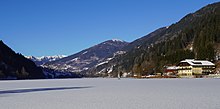Afritzer See
| Afritzer See | ||
|---|---|---|

|
||
| Afritzer See, looking west | ||
| Geographical location | Umgebung Valley , Carinthia , Austria | |
| Drain | Afritzer Bach | |
| Data | ||
| Coordinates | 46 ° 44 '43 " N , 13 ° 46' 5" E | |
|
|
||
| Altitude above sea level | 752 m above sea level A. | |
| surface | 48.8 ha | |
| length | 1.5 km | |
| width | 380 m | |
| volume | 6,946,000 m³ | |
| Maximum depth | 22.5 m | |
| Middle deep | 14.2 m | |
The Afritzer See is a lake in Carinthia . It is located in the Nahe valley north of Villach in the municipality of Feld am See .
location
The lake is located in the region valley in the Nock Mountains at an altitude of 752 m above sea level. A. between the Wöllaner Nock and the Mirnock . It is located on the southern edge of the municipal area of Feld am See , in some cases the municipal boundary to Afritz follows the shoreline. The southeast bank is largely untouched. Millstätter Straße (B 98) runs along the northeast bank .
The lake is the remains of a once larger lake. This was divided by a rock fall from the Mirnock (Lierzberger Alpenspitz - Wieserwald): into the Afritzer See and the Feldsee . The two lakes are separated by a flat valley watershed . The Afritzsee drains to the southeast in the direction of Treffen.
The lake is fed by a few small brooks that have created alluvial cones, especially on the south and west banks.
Since the lake is located in an often windy valley furrow, it does not reach the high water temperatures of other Carinthian lakes . Nevertheless, it is strictly stratified in summer, the surface temperatures exceed 23 ° C in summer.
fauna and Flora
The following fish species have been recorded from the Afritzersee: eel , whitefish , chub , carp , arbor , roach , tench , Pickerel , pike , perch , pike and catfish . The migrating mussel has been found in the lake since 1980 .
The stocks of the noble crayfish have fallen victim to the cancer plague . Since 1992 there have been attempts to reintroduce the noble crayfish in the lake.
Canadian waterweed began to spread in the lake in 1976 . It has filled the entire belt of the riverbank and severely impaired bathing operations. It has been fought mechanically since 1978, for example with underwater mowing boats, and its population has decreased over time. However, it still has to be removed regularly, at least in the bathing area.
The phytoplankton is composed differently depending on the year and season. The following species can make up a larger proportion of the biomass: Burgundy blood algae , Anabaena spp., Microcystis aeruginosa ( cyanobacteria ); Cyclotella , Synedra acus , Asterionella formosa , Fragilaria crotonensis ( diatoms ); Uroglena , Dinobryon ( Chrysophyceae ); Ceratium hirundinella , Gymnodinium spp., Peridinium ( dinoflagellates ); Cryptomonas ( Cryptophyceae ). Green algae like Chlamydomonas only play a minor role.
use
The Afritzer See is used as a bathing lake. There are two bathing beaches and a campsite on the south bank. In the 2009 season the lake was classified as weakly mesotrophic and the hygiene was very good. In 2010 the overall situation was also assessed as very good.
The use of angling produces quite high yields of 30 to 40 kg per hectare.
Landscape protection area
The Afritzersee resides on a conservation area . It was established in 1970 (LGBl. 86/1970) and covers 144 hectares. In addition to the lake, it includes its peripheral areas on the west, north and east banks. The conservation area is located in the communities of Feld am See and Afritz .
Individual evidence
- ↑ a b c d e Carinthian Institute for Lake Research: Carinthian Lake Report 1992. 60 years of lake research, 30 years of lake restoration . (= Publications by the Carinthian Institute for Lake Research 7) Klagenfurt 1992, pp. 383–397.
- ↑ a b c Helmut Hartl, Hans Sampl, Ralf Unkart: Treasures of Carinthia. National parks, nature reserves, landscape reserves, natural monuments . Kärntner Druck- und Verlagsgesellschaft, Klagenfurt 1993, ISBN 3-85391-092-0 , p. 54.
- ↑ a b c Afritzer See at the Carinthian Institute for Lake Research , accessed March 12, 2011.
- ↑ Hans Sampl: The waters of the region . In: The Nockberge. A nature guide . Publishing house of the Natural Science Association for Carinthia, Klagenfurt 2003, pp. 35–44. ISBN 3-85328-031-5
- ↑ a b Lake Report 2009 , accessed on March 12, 2011.
- ^ Swimming water quality 2010 , accessed on March 12, 2011.
Web links
- Afritzer See (Carinthian Institute for Lake Research)




